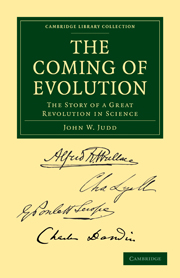Book contents
- Frontmatter
- Contents
- CHAP. I Introductory
- CHAP. II Origin of the Idea of Evolution
- CHAP. III The Development of the Idea of Evolution to the Inorganic World
- CHAP. IV The Triumph of Catastrophism over Evolution
- CHAP. V The Revolt Scrope and Lyell against Catastrophism
- CHAP. VI The Principles of Geology
- CHAP. VII The Influence of Lyell's Works
- CHAP. VIII Early Attempts to establish the Doctrine of Evolution for the Organic World
- CHAP. IX Darwin and Wallace: The Theory of Natural Selection
- CHAP. X The Origin of Species
- CHAP. XI The Influence of Drawin's Works
- CHAP. XII The Place of Lyell and Darwin in History
- Notes
- Index
- Plate section
CHAP. IX - Darwin and Wallace: The Theory of Natural Selection
Published online by Cambridge University Press: 07 September 2010
- Frontmatter
- Contents
- CHAP. I Introductory
- CHAP. II Origin of the Idea of Evolution
- CHAP. III The Development of the Idea of Evolution to the Inorganic World
- CHAP. IV The Triumph of Catastrophism over Evolution
- CHAP. V The Revolt Scrope and Lyell against Catastrophism
- CHAP. VI The Principles of Geology
- CHAP. VII The Influence of Lyell's Works
- CHAP. VIII Early Attempts to establish the Doctrine of Evolution for the Organic World
- CHAP. IX Darwin and Wallace: The Theory of Natural Selection
- CHAP. X The Origin of Species
- CHAP. XI The Influence of Drawin's Works
- CHAP. XII The Place of Lyell and Darwin in History
- Notes
- Index
- Plate section
Summary
Charles Darwin was the grandson of Erasmus Darwin, who, as we have seen, arrived independently at conclusions concerning the origin of species very similar to those of Lamarck, and embodied his views in poems, which, at the time of their publication, achieved a considerable popularity. In the younger philosopher, however, imagination was always kept in subjection by a determination to ‘prove all things’ and ‘to hold fast that which is good’ though, in other respects, there were not wanting indications of the existence of hereditary characteristics in the grandson.
Born at Shrewsbury and educated in the public school of that town, Charles Darwin from the first exhibited signs of individuality in his ideas and his tastes. The rigid classical teaching of his school did not touch him, but, with the aid of his elder brother, he surreptitiously started a chemical laboratory in a garden tool-house. From his earliest infancy, he was a collector, first of trifles, like seals and franks, but later of stones, minerals and beetles.
At the outset, only the desire to possess new things animated him, then a wish to put names to them, but, at a very early period, a passion arose for learning all he could about them.
- Type
- Chapter
- Information
- The Coming of EvolutionThe Story of a Great Revolution in Science, pp. 95 - 114Publisher: Cambridge University PressPrint publication year: 2009First published in: 1910



